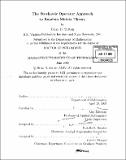| dc.contributor.advisor | Alan Edelman. | en_US |
| dc.contributor.author | Sutton, Brian D. (Brian David) | en_US |
| dc.contributor.other | Massachusetts Institute of Technology. Dept. of Mathematics. | en_US |
| dc.date.accessioned | 2006-06-19T17:39:53Z | |
| dc.date.available | 2006-06-19T17:39:53Z | |
| dc.date.copyright | 2005 | en_US |
| dc.date.issued | 2005 | en_US |
| dc.identifier.uri | http://hdl.handle.net/1721.1/33094 | |
| dc.description | Thesis (Ph. D.)--Massachusetts Institute of Technology, Dept. of Mathematics, 2005. | en_US |
| dc.description | Includes bibliographical references (p. 147-150) and index. | en_US |
| dc.description.abstract | Classical random matrix models are formed from dense matrices with Gaussian entries. Their eigenvalues have features that have been observed in combinatorics, statistical mechanics, quantum mechanics, and even the zeros of the Riemann zeta function. However, their eigenvectors are Haar-distributed-completely random. Therefore, these classical random matrices are rarely considered as operators. The stochastic operator approach to random matrix theory, introduced here, shows that it is actually quite natural and quite useful to view random matrices as random operators. The first step is to perform a change of basis, replacing the traditional Gaussian random matrix models by carefully chosen distributions on structured, e.g., tridiagonal, matrices. These structured random matrix models were introduced by Dumitriu and Edelman, and of course have the same eigenvalue distributions as the classical models, since they are equivalent up to similarity transformation. This dissertation shows that these structured random matrix models, appropriately rescaled, are finite difference approximations to stochastic differential operators. Specifically, as the size of one of these matrices approaches infinity, it looks more and more like an operator constructed from either the Airy operator, ..., or one of the Bessel operators, ..., plus noise. One of the major advantages to the stochastic operator approach is a new method for working in "general [beta] " random matrix theory. In the stochastic operator approach, there is always a parameter [beta] which is inversely proportional to the variance of the noise. | en_US |
| dc.description.abstract | (cont.) In contrast, the traditional Gaussian random matrix models identify the parameter [beta] with the real dimension of the division algebra of elements, limiting much study to the cases [beta] = 1 (real entries), [beta] = 2 (complex entries), and [beta] = 4 (quaternion entries). An application to general [beta] random matrix theory is presented, specifically regarding the universal largest eigenvalue distributions. In the cases [beta] = 1, 2, 4, Tracy and Widom derived exact formulas for these distributions. However, little is known about the general [beta] case. In this dissertation, the stochastic operator approach is used to derive a new asymptotic expansion for the mean, valid near [beta] = [infinity]. The expression is built from the eigendecomposition of the Airy operator, suggesting the intrinsic role of differential operators. This dissertation also introduces a new matrix model for the Jacobi ensemble, solving a problem posed by Dumitriu and Edelman, and enabling the extension of the stochastic operator approach to the Jacobi case. | en_US |
| dc.description.statementofresponsibility | by Brian D. Sutton. | en_US |
| dc.format.extent | 156 p. | en_US |
| dc.format.extent | 6534500 bytes | |
| dc.format.extent | 6543035 bytes | |
| dc.format.mimetype | application/pdf | |
| dc.format.mimetype | application/pdf | |
| dc.language.iso | eng | en_US |
| dc.publisher | Massachusetts Institute of Technology | en_US |
| dc.rights | M.I.T. theses are protected by copyright. They may be viewed from this source for any purpose, but reproduction or distribution in any format is prohibited without written permission. See provided URL for inquiries about permission. | en_US |
| dc.rights.uri | http://dspace.mit.edu/handle/1721.1/7582 | |
| dc.subject | Mathematics. | en_US |
| dc.title | The stochastic operator approach to random matrix theory | en_US |
| dc.type | Thesis | en_US |
| dc.description.degree | Ph.D. | en_US |
| dc.contributor.department | Massachusetts Institute of Technology. Department of Mathematics | |
| dc.identifier.oclc | 62174154 | en_US |
